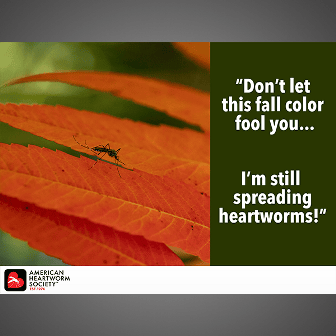TOM NELSON, DVM
Q. While the American Heartworm Society (AHS) recommends year-round heartworm prevention for dogs and cats, many veterinarians and owners take a seasonal approach. What is the AHS’ rationale?
A. Back in 1995, Drs. David Knight and James Lok made the case that veterinarians should take a seasonal approach to heartworm prevention recommendations. Their premise: mosquitoes need relatively warm conditions (~57°F) for heartworm larvae to develop to the infective stage. Using a model based on National Weather Service (NWS) data and the assumption that the mosquito lifespan is 30 days, they calculated the beginning and end of heartworm “season” in locales across the country. While year-round prevention was still recommended in extreme southern cities, the season was believed to be as short as three months along the Canadian border.
Q. Most of us aren’t seeing mosquitoes in December. Doesn’t it make sense to time heartworm prevention with the mosquito season?
A. The model referenced above has limitations, based on the following factors:
- All mosquitoes are not alike. While some mosquitoes have a 30-day lifespan,
several significant mosquito vectors live and breed for up to 3 months. Among these is Aedes albopictus (the Asian Tiger Mosquito), an urban dwelling mosquito that is adaptive to colder weather. Some mosquito species, such as Anopheles quadrimaculatus, have been shown to overwinter. Heartworm larval development in the mosquito may cease in cool temperatures, but quickly resumes when temperatures warm. Many more mosquito species that live in the U.S. are capable of transmitting heartworms, and each has its own set of biological habits. - Temperature data can be deceiving. The model used NWS temperature data. However, these collection stations are typically in open, unprotected areas where temperatures may be lower than where mosquitoes and pets actually live. Between November 1, 2015 and April 30, 2016, I conducted a study in which individuals in 15 locations across the country placed measuring devices that recorded hourly temperatures in three areas: (1) a location similar to their NWS station; (2) a protected area with outside contact (e.g. an unheated garage, house foundation or crawl space); and (3) a shaded area 25 feet from device #2. The result: data collected from the #2 devices recorded average temperatures of 8-17 °F higher than those in the NWS-modeled locations.
- Microclimates can be mosquito-friendly. Urban sprawl has led to the formation of “heat islands,” as buildings and parking lots retain heat during the day. Temperatures in these microenvironments can be much higher and more conducive to the persistence of mosquito viability.
Q. When should veterinarians recommend giving heartworm preventives?
A. Questioning the need for year-round heartworm prevention is understandable, given that heartworm transmission decreases in winter months. However, the risk of transmission may never reach zero—or if it does, it may be impossible to accurately predict. That is why the AHS recommends year-round prevention. Keeping owners in the habit of giving preventives on an uninterrupted basis keeps pets protected and eliminates the risk of trying to outsmart the most dangerous creature on earth.







